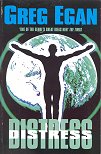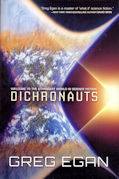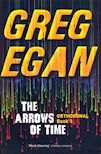In 2037 the stars went out: The Bubble suddenly came into existence, surrounding the solar system, quarantining mankind inside. By now, 33 years later, most people have learned to live with that stupendous event. Nick Stavrianos, private investigator, is one of those -- but his life is turned upside down when an anonymous client hires him to track down Laura Andrews, a severely disabled mental defective who has impossibly gone missing from her secure institution, and for no apparent reason.
This is a heady mix of typical Egan-esque ideas -- nanotech neural modifications of mind and mood, gene manipulations of body chemistry, the consequences of quantum mechanics, the changes to humanity brought about by paradigm-altering technology, great gobs of cognitive philosophy -- all deep ideas integrated into a fascinating, complex, fast moving plot. I much prefer Egan's terse, punchy style over that of more verbose, well-padded authors: we get a variety of neural modifications, Laura's abduction, Nick's dead wife, and the star-quenching Bubble ... in just the first three pages! All this without sacrificing any depth or complexity later. In the hands of a lesser author, this might indicate typical First Novel syndrome -- every idea crammed into the story, not because it fits, but just because it's neat. But Egan weaves everything together so that it feels a natural part of the future world.
I'm not entirely convinced by the way the Many Worlds Interpretation of QM is combined with Copenhagen collapsing wavefunctions -- but the opportunities it gives, along with the neural mods, for exploring what it means to be me, rather that someone else rather similar, are fascinating. And I want (some of) those neural mods!



















